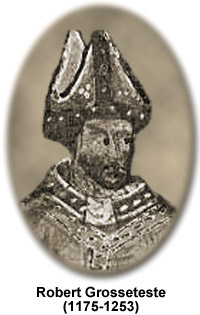Robert Grosseteste
(1175-1253)

The Middle Ages have been largely considered a period of stagnation in thought since fifteenth-century Italian humanists attempted to separate themselves from their predecessors and began to trumpet ideals they believed they held in common with the ancient Greeks and Romans. The approximately one thousand year period that passed after the sack of Rome by the Visigoths, however, was not as dark as it is often portrayed. A number of advances were made in the Middle Ages in a wide variety of fields, including optics. Robert Grosseteste and his famous pupil, Roger Bacon, for instance, were both intrigued by light and its associated phenomena and made notable steps in the discipline.
Robert Grosseteste was born around 1175 in Suffolk, England and attended the University of Oxford. Subsequently, he accepted a position under William de Vere, the Bishop of Hereford, and in 1215, Grosseteste became chancellor of Oxford. In 1221, Grosseteste left his post at the university and was provided with various sinecures, advancing steadily through the ecclesiastical ranks. In 1235, he was appointed Bishop of Lincoln, but for approximately five years prior to that time he served as a theology lecturer to the Franciscans, on whom he had a tremendous impact. Grosseteste’s religious views included a belief in the necessity of a highly hierarchical, centralized church, which he considered to be superior to the state, and an emphasis on the cure of souls. However, Grosseteste’s dedication to his religion did not blind him to concerns raised by science, and he consistently attempted to find rational answers to questions related to both the natural and spiritual worlds.
Grosseteste’s earliest influence on the scientific thought of his day was through the translation of a number of Greek and Arabic scientific works into Latin. On some of these translations, including several important writings by Aristotle, he composed insightful commentaries. Grosseteste was particularly interested in astronomy and mathematics, and he asserted that the latter was essential to investigations of natural phenomena. Consequently, his study of light often took a mathematical turn, resulting in a refinement of optical science. In his investigations of rainbows, comets, and other optical phenomena, he notably made use of both observational data and mathematical formulations. Moreover, Grosseteste was an early proponent of the need for experimental support of scientific theories (a view he clearly passed on to Bacon during his tutelage), and carried out numerous experiments with mirrors and lenses.
Findings from many of Grosseteste’s experiments with light appear in a number of treatises. In De Natura Locorum, for example, he provides a diagram related to experimental work with refraction, which illustrates light being refracted when passing through a glass container filled with water. The most famous of Grosseteste’s scientific writings, however, was De Luce (On Light), which was composed between 1215 and 1220. Largely based on biblical, rather than experimental, evidence, Grosseteste argues in De Luce that light is the most basic form of all matter. According to the scholar’s metaphysical outlook, “light is not a form subsequent to corporeity, but it is corporeity itself.”
